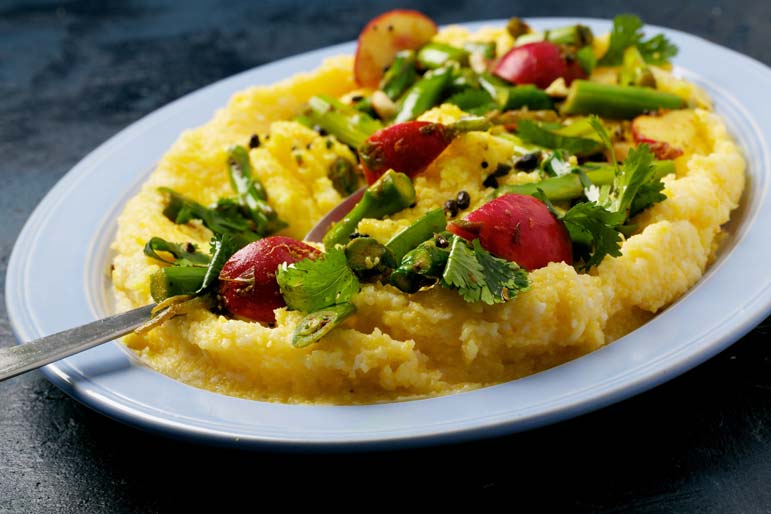 Deb Lindsey for The Washington Post
Deb Lindsey for The Washington Post
Brooklyn Delhi co-founder Chitra Agrawal has signed on to help, via her new, first cookbook. This dish, from "Vibrant India," features a spiced spring vegetable stir-fry over polenta with a subtle amount of coconut stirred in. It's served for breakfast or a light snack in Southern India, she reports in the recipe headnote. In addition to the curry leaves, black mustard seed and ground turmeric, a mere teaspoon of chana or urad dal gives the mix its regional flair.
Trouble is, there aren't many places that sell small quantities of those dried split chickpeas or split lentils. Curry leaves typically are in short supply even at Indian markets. So just how important are they to this dish?
"The dal are used for texture and color," Agrawal says, and they impart a slight nuttiness. The choice of either chana or urad has more to do with her family's preferences; chana dal are a bit more substantial, and both bring a tiny amount of protein to the party. You don't have to use them or the curry leaves here, she says. But if you do, the author calls for them in some spice blends in the book. And here are a few other ways to use the dal:
• Soak the chana dal for two hours in room-temperature water; they will become quite soft. Drain well and sprinkle them into salads.
• Use the urad dal to make dosas.
• Both dals can be used in your favorite lentil soup recipes; soak them overnight before using. They may take longer to cook than green, brown or red lentils, Agrawal says.
• Grind the dals into a coarse powder, add herbs and fry patties like falafel. Agrawal likes to serve the vegetable polenta dish with a dollop of yogurt or pat of butter on top, or one of the small-batch pickles her company makes.
![]()
SPICED SPRING VEGETABLES AND COCONUT POLENTA
4 servings
Here's breakfast-for-dinner, South Indian style, with a riff on a traditional vegetable stir-fry called uppittu or upma. Its author tweaked the recipe for her gluten-free friends by using polenta instead of semolina (couscous) as a base. Stirring coconut into it results in a delightfully fluffy texture.
Chana dal are skinned, split black chickpeas (they are yellow) and urad dal are skinned, split black lentils (they are white). Both, and curry leaves, are available at Indian markets and some well-stocked international aisles of large supermarkets.
Serve with plain yogurt.
Adapted from "Vibrant India: Fresh Vegetarian Recipes From Bangalore to Brooklyn," by Chitra Agrawal (Penguin/Random House, 2017).
Ingredients
- 1/2 cup unsweetened, grated, fresh, frozen or dried coconut (see headnote)
- Hot water, plus 4 cups water, or more as needed
- 8 ounces asparagus (about 10 stalks)
- About 2 ounces sugar snap peas (a good handful)
- 1/2-inch piece fresh ginger root
- 1 small serrano pepper or Indian finger chile pepper
- 4 or 5 red radishes
- 2 scallions
- 4 stems cilantro
- 1 teaspoon salt, plus more as needed
- 1 cup quick-cooking polenta (may substitute stone-ground cornmeal)
- 2 tablespoons unsalted butter
- 1 1/2 tablespoons coconut oil
- 1 teaspoon black mustard seed
- 1 teaspoon chana dal or urad dal (see headnote)
- 5 or 6 fresh curry leaves (optional; see headnote)
- 1/2 teaspoon ground turmeric
- 1/2 lemon, or more as needed
- Roasted, unsalted cashews, for garnish (optional)
Steps
If you're using frozen or dried coconut, place in a medium bowl and cover with hot water; let sit for a few minutes until defrosted or slightly rehydrated, then drain.
Discard the tough ends of the asparagus, then cut the rest into 1-inch pieces. String the snap peas and cut on the diagonal into 1-inch pieces. Peel the ginger, then grate it. Stem and seed the chile pepper, then mince it.
Trim the radishes and cut into quarters from top to bottom. Trim the scallions, then chop the white and light-green parts. Tear or coarsely chop the cilantro leaves.
Bring the 4 cups of water to a boil in a medium saucepan over medium-high heat. Add the teaspoon of salt, then gradually stir in the polenta; reduce the heat to medium-low and cook, stirring, until it is creamy and lump-free. Stir in the butter and coconut; the polenta should become lighter and fluffier. Partially cover and reduce the heat to its lowest setting.
Heat the oil in medium nonstick skillet or wok over medium heat. Once the oil is shimmering, add a single black mustard seed. If it pops and sizzles, add the rest; have a splatter cover nearby and use it, as needed. Once the popping/sizzling subsides, stir in the chana or urad dal, if using, then reduce the heat to medium-low.
Cook, stirring for a minute or two until the dal's color deepens, then add the curry leaves, if using, and the ginger and chile pepper. Cover quickly to avoid spatters; cook for about 10 seconds, then add the scallions and ground turmeric. Stir-fry for 1 minute, then add the asparagus, snap peas and radishes (to taste). Season lightly with salt. Increase the heat to high; stir-fry for 2 or 3 minutes; if the mixture seems dry, add a splash or two of water. Turn off the heat and add the cilantro.
Divide the polenta among individual wide, shallow bowls or spread across a platter. Top with the spiced vegetable mixture. Squeeze some juice from the lemon half over the top. Coarsely chop or crush the cashews, if using, and sprinkle over the mix. Serve right away.
Nutrition | Per serving (using chana dal): 360 calories, 6 g protein, 41 g carbohydrates, 20 g fat, 8 g saturated fat, 15 mg cholesterol, 600 mg sodium, 6 g dietary fiber, 2 g sugar


 Contact The Editor
Contact The Editor
 Articles By This Author
Articles By This Author